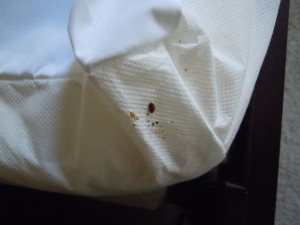READY TO GET STARTED?
REQUEST A FREE ESTIMATE
Fill out the form below or call (888) 466-7849 for a free, no-obligation estimate.
Summer vacation is almost over and before we know it schools and universities will be back in session. While shopping for school supplies and a new wardrobe might take precedence over bed bug prevention, Northwest Exterminating, a pest control management company, encourages parents and students to also spend some time brushing up on bed bug prevention tips.
Bed bugs are excellent hitchhikers and thrive in heavily populated places. This makes classrooms and dorms the perfect settings for bed bugs to take up residence.
A study conducted by the National Pest Management Association (NPMA) and the University of Kentucky found that bed bug infestations are on the rise in many different types of dwellings, including school and college settings. According to the survey, 47 percent of respondents had treated for bed bugs in college dorms in 2013, while 41 percent had reported bed bug infestations in schools and daycare centers.
NPMA also advises college students to take steps to protect against bed bugs, including:
For more information on bed bugs, please visit our Bed Bug Control page.
It’s not just a nursery rhyme anymore, it’s a way of life. Bedbugs are a real concern for people, especially those that travel, but those that stay close to home aren’t exempt from the threat of bedbugs. Luckily, bedbugs are more of a nuisance than a health hazard. Although not a health risk, it is imperative that you call a licensed pest professional if you think you have a bedbug infestation.
Bedbugs are small, flat, wingless insects with 6 legs. Like mosquitoes, bedbugs feed on the blood of animals and humans. They are brown in color and turn a reddish brown after a feeding. Read more on how to ID a bedbug HERE.
Bedbugs are great hitchhikers. They can catch a ride on luggage, purses, clothing, pets, boxes, and other belongings that are taken from place to place. That is why bedbugs are often found in hotels, apartments, dorm rooms, places where people often come and go. Bedbugs are a world-wide issue. At one time, they were most common in developing countries but due to increased international travel, they are an issue in the US and other developed countries.
As stated earlier, bed bugs feed on blood from humans and animals. They typically feed at night. After they feed, they become engorged and fall off of their host. It only takes them about 3 minutes to complete their meal. They can go weeks without feeding.
Bedbugs inject a numbing agent in the body when feeding. In most cases, you won’t know if you are being bitten by a bedbug.
Bedbugs bites are itchy, red bumps, usually left in a straight line, on the skin. Bites are usually found on the upper body.
It’s simple. Hire a licensed pest professional if you think you have a bedbug infestation. They can be very difficult to treat. In the mean time, inspect all mattresses and bedding, especially when traveling. Avoid putting your luggage on the floor or bed, instead use a luggage rack. When returning home, wash and dry clothing on the highest heat level. Make sure to check the cracks and crevices of any luggage before storing.
Brief description:
Habits:
Different species:
Threats:
Prevention:
Other pests to look out for:
 So long are the days of only having to worry that your kids may get head lice in school…you can now add bed bugs to that list. You’ve heard about the risk of bed bugs when returning back to college but now bed bugs are popping up in elementary, middle, and high schools.
So long are the days of only having to worry that your kids may get head lice in school…you can now add bed bugs to that list. You’ve heard about the risk of bed bugs when returning back to college but now bed bugs are popping up in elementary, middle, and high schools.
Bed bugs are making their way into schools through back packs. And while they can’t be transferred from person to person, they can be transferred from back pack to back pack.
The good news is that bed bugs are NOT a sanitation issue and they do not carry diseases. Bed bugs are not a sign of a dirty home but they are very difficult to get rid of.
If you are notified that there may be a chance that your child’s back pack has been infested do not panic…there are things you can do to ensure that they are not brought into your home.
For more information on bed bugs visit the Georgia Department of Public Heath: http://www.health.state.ga.us/epi/zvbd/infest/index.asp
 It’s a rite of passage for many college students to be on their own in a dorm or apartment. Parents go to inspect the new place of residency, making sure all is safe. But is it really safe? Dorm room bed bug problems are becoming increasingly more prevalent.
It’s a rite of passage for many college students to be on their own in a dorm or apartment. Parents go to inspect the new place of residency, making sure all is safe. But is it really safe? Dorm room bed bug problems are becoming increasingly more prevalent.
Bed bugs are small insects that are brown to reddish brown in color and broadly oval and flat in shape. Bed bugs harbor in cracks and crevices during the day and come out to feed at night. They prefer to feed on humans but will feed on other warm blooded animals. Typically, they can be found around mattresses, in box springs or their coverings, and in any crevice of a wooden bed frame, such as where members join. Before students move ANY of their belongings into their new home, they should check in and around wall hangings such as picture frames, night stands, stuffed furniture, baseboards, floorboard cracks, behind loose wallpaper, light switches, door and window frames, conduits, etc. Also check mattress covers for small, brownish stains. It would be wise to purchase mattress and box spring encasings as a precaution.
Bed bugs can be introduced into a structure via used furniture, clothing, boxes, suitcases, or other goods that are moved from residence to residence. Keep this in mind when your kids come home from college to visit. Make sure to check bags and boxes thoroughly before they enter your home.
Bed bugs are most active at night and bite any exposed areas of skin while an individual is sleeping. The face, neck, hands, and arms are common sites for bed bug bites. The bite itself is painless and is not noticed. Small, flat, or raised bumps on the skin are the most common sign; redness, swelling, and itching commonly occur. If scratched, the bite areas can become infected. A peculiarity of bed bug bites is the tendency to find several bites lined up in a row. Infectious disease specialists refer to this as the “breakfast, lunch, and dinner” sign signifying the sequential feeding that occurs from site to site.
Getting rid of bed bugs is not an easy process and most cases of bed bug infestations will require treatment by a pest control expert. If bed bugs are suspected in a dorm room, contact the RA (Residential Adviser) immediately and make sure that they use a pest control expert like Northwest Exterminating.
Do you have a child going off to college this year?